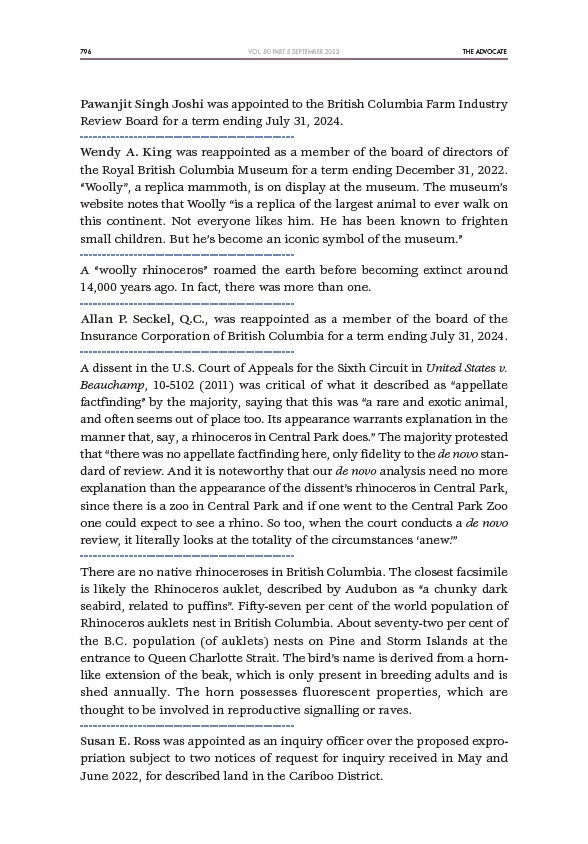
796 THE ADVOCATE
VOL. 80 PART 5 SEPTEMBER 2022
Pawanjit Singh Joshi was appointed to the British Columbia Farm Industry
Review Board for a term ending July 31, 2024.
Wendy A. King was reappointed as a member of the board of directors of
the Royal British Columbia Museum for a term ending December 31, 2022.
“Woolly”, a replica mammoth, is on display at the museum. The museum’s
website notes that Woolly “is a replica of the largest animal to ever walk on
this continent. Not everyone likes him. He has been known to frighten
small children. But he’s become an iconic symbol of the museum.”
A “woolly rhinoceros” roamed the earth before becoming extinct around
14,000 years ago. In fact, there was more than one.
Allan P. Seckel, Q.C., was reappointed as a member of the board of the
Insurance Corporation of British Columbia for a term ending July 31, 2024.
A dissent in the U.S. Court of Appeals for the Sixth Circuit in United States v.
Beauchamp, 10-5102 (2011) was critical of what it described as “appellate
factfinding” by the majority, saying that this was “a rare and exotic animal,
and often seems out of place too. Its appearance warrants explanation in the
manner that, say, a rhinoceros in Central Park does.” The majority protested
that “there was no appellate factfinding here, only fidelity to the de novo standard
of review. And it is noteworthy that our de novo analysis need no more
explanation than the appearance of the dissent’s rhinoceros in Central Park,
since there is a zoo in Central Park and if one went to the Central Park Zoo
one could expect to see a rhino. So too, when the court conducts a de novo
review, it literally looks at the totality of the circumstances ‘anew.’”
There are no native rhinoceroses in British Columbia. The closest facsimile
is likely the Rhinoceros auklet, described by Audubon as “a chunky dark
seabird, related to puffins”. Fifty-seven per cent of the world population of
Rhinoceros auklets nest in British Columbia. About seventy-two per cent of
the B.C. population (of auklets) nests on Pine and Storm Islands at the
entrance to Queen Charlotte Strait. The bird’s name is derived from a hornlike
extension of the beak, which is only present in breeding adults and is
shed annually. The horn possesses fluorescent properties, which are
thought to be involved in reproductive signalling or raves.
Susan E. Ross was appointed as an inquiry officer over the proposed expropriation
subject to two notices of request for inquiry received in May and
June 2022, for described land in the Cariboo District.